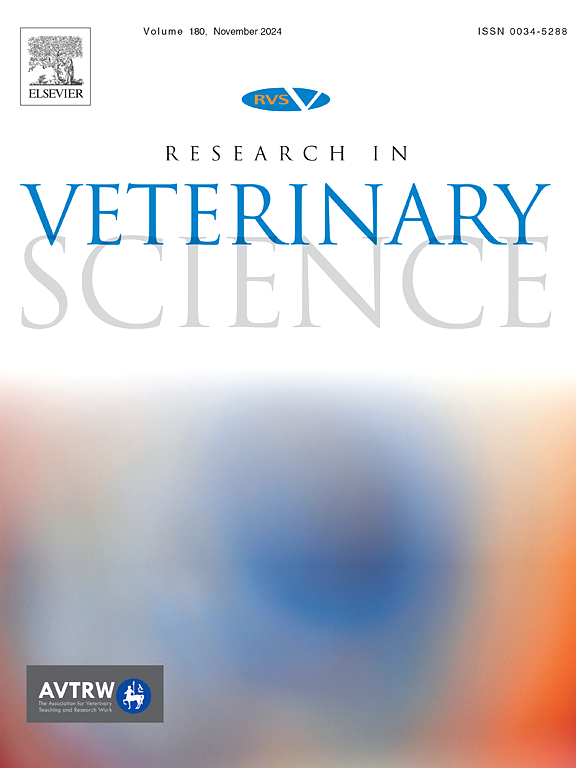Molecular detection, epidemiology and phylogenetic evaluation of Babesia ovis in apparently healthy goats
IF 2.2
3区 农林科学
Q1 VETERINARY SCIENCES
引用次数: 0
Abstract
Babesia (B.) ovis is an intra-erythrocytic protozoan parasite that infects small ruminants globally, causing economic losses. This study aimed to investigate the molecular prevalence of B. ovis in 1200 asymptomatic goats of various breeds across four districts in Punjab, Pakistan: Layyah, Lohdran, Dera Ghazi Khan, and Rajanpur. The enrolled goats represented ten breeds, including Daira Din Pannah (n = 890), Pahari goat (n = 68), Nukri (n = 44), Teddy (n = 37), Lail Puri (n = 36), Beetal (n = 36), Dessi (n = 32), Makhi Cheena (n = 27), Muhammad Puri (n = 19) and Fazil Puri (n = 11). The hematological and biochemical profiles of the goats, risk factors associated with the infection, and the phylogenetic relationship of the detected isolates were also evaluated. In total, 105 blood samples (9.6 %) tested positive by PCR. Sanger sequencing of a partial fragment of the 18S rRNA gene confirmed B. ovis. Phylogenetic analysis of the 18S rRNA gene sequences revealed 99–100 % similarity with isolates previously reported from Iran, Iraq, Turkey, and Spain. The infection rate varied across districts, with the highest prevalence observed in goats from Rajanpur (13 %), followed by Dera Ghazi Khan (11 %), Layyah (7 %), and Lohdran (5 %) (P = 0.003). The susceptibility to infection varied among goat breeds, with Lail Puri breed showing the highest susceptibility (P = 0.03). Risk factor analysis revealed that goats under one year of age and those kept on farms where other animals and dogs were also present had higher B. ovis infection rates. Babesia ovis-infected goats showed reductions in white and red blood cells, hemoglobin concentration, and alterations in serum aspartate aminotransferase and creatinine levels. This study provides updated data on the prevalence of B. ovis in local Pakistani goat populations, emphasizing the need for integrated control strategies against this tick-borne pathogen.
表面健康山羊巴贝斯虫的分子检测、流行病学及系统发育评价
巴贝斯虫(B.) ovis)是一种红细胞内原虫寄生虫,感染全球的小型反刍动物,造成经济损失。本研究旨在调查巴基斯坦旁遮普省4个地区(Layyah、Lohdran、Dera Ghazi Khan和Rajanpur) 1200只不同品种无症状山羊的分子流行情况。登记的山羊共有10个品种,包括Daira Din Pannah (n = 890)、Pahari山羊(n = 68)、Nukri山羊(n = 44)、Teddy山羊(n = 37)、Lail Puri山羊(n = 36)、Beetal山羊(n = 36)、Dessi山羊(n = 32)、Makhi Cheena山羊(n = 27)、Muhammad Puri山羊(n = 19)和Fazil Puri山羊(n = 11)。对山羊的血液学和生化特征、与感染相关的危险因素以及检测到的分离株的系统发育关系进行了评估。共有105份血样(9.6%)经PCR检测呈阳性。对18S rRNA基因的部分片段进行Sanger测序,证实为B. ovis。系统发育分析显示,该株18S rRNA基因序列与先前报道的伊朗、伊拉克、土耳其和西班牙分离株相似度为99 - 100%。不同地区的感染率各不相同,Rajanpur的山羊感染率最高(13%),其次是Dera Ghazi Khan(11%)、Layyah(7%)和Lohdran (5%) (P = 0.003)。不同山羊品种对感染的易感性存在差异,以Lail Puri品种易感性最高(P = 0.03)。风险因素分析显示,一岁以下的山羊和饲养在有其他动物和狗的农场的山羊具有较高的卵巢双球菌感染率。感染巴贝斯虫的山羊表现出白细胞和红细胞减少,血红蛋白浓度降低,血清天冬氨酸转氨酶和肌酐水平改变。本研究提供了巴基斯坦当地山羊种群中羊双球菌流行情况的最新数据,强调了对这种蜱传病原体采取综合控制策略的必要性。
本文章由计算机程序翻译,如有差异,请以英文原文为准。
求助全文
约1分钟内获得全文
求助全文
来源期刊

Research in veterinary science
农林科学-兽医学
CiteScore
4.40
自引率
4.20%
发文量
312
审稿时长
75 days
期刊介绍:
Research in Veterinary Science is an International multi-disciplinary journal publishing original articles, reviews and short communications of a high scientific and ethical standard in all aspects of veterinary and biomedical research.
The primary aim of the journal is to inform veterinary and biomedical scientists of significant advances in veterinary and related research through prompt publication and dissemination. Secondly, the journal aims to provide a general multi-disciplinary forum for discussion and debate of news and issues concerning veterinary science. Thirdly, to promote the dissemination of knowledge to a broader range of professions, globally.
High quality papers on all species of animals are considered, particularly those considered to be of high scientific importance and originality, and with interdisciplinary interest. The journal encourages papers providing results that have clear implications for understanding disease pathogenesis and for the development of control measures or treatments, as well as those dealing with a comparative biomedical approach, which represents a substantial improvement to animal and human health.
Studies without a robust scientific hypothesis or that are preliminary, or of weak originality, as well as negative results, are not appropriate for the journal. Furthermore, observational approaches, case studies or field reports lacking an advancement in general knowledge do not fall within the scope of the journal.
 求助内容:
求助内容: 应助结果提醒方式:
应助结果提醒方式:


